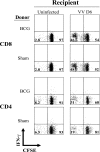CD4 T-cell-mediated heterologous immunity between mycobacteria and poxviruses
- PMID: 19193795
- PMCID: PMC2663272
- DOI: 10.1128/JVI.02393-08
CD4 T-cell-mediated heterologous immunity between mycobacteria and poxviruses
Abstract
The bacillus Calmette-Guerin (BCG) strain of Mycobacterium bovis is used in many parts of the world as a vaccine against Mycobacterium tuberculosis. Some epidemiological evidence has suggested that BCG immunization may have unpredicted effects on resistance to other pathogens. We show here in a mouse model that BCG immunization followed by antibiotic treatment to clear the host of the pathogen rendered three strains of mice partially resistant to infection with vaccinia virus (VV) but not to lymphocytic choriomeningitis virus (LCMV). VV-challenged BCG-immune mice developed a striking splenomegaly and elevated CD4 and CD8 T-cell responses by 6 days postinfection (p.i.). However, resistance to VV infection could be seen as early as 1 to 2 days p.i. and was lost after antibody depletion of CD4 T-cell populations. BCG- but not LCMV-immune memory phenotype CD4 T cells preferentially produced gamma interferon (IFN-gamma) in vivo after VV challenge. In contrast, LCMV-immune CD8 T cells preferentially produced IFN-gamma in vivo in response to VV infection. In BCG-immune mice the resistance to VV infection and VV-induced CD4 T-cell IFN-gamma production were ablated by cyclosporine A, which inhibits signaling through the T-cell receptor. This study therefore demonstrates CD4 T-cell-mediated heterologous immunity between a bacterium and virus. Further, it poses the question of whether BCG immunization of humans alters resistance to unrelated pathogens.
Figures






References
-
- Barton, E. S., D. W. White, J. S. Cathelyn, K. A. Brett-McClellan, M. Engle, M. S. Diamond, V. L. Miller, and H. W. Virgin. 2007. Herpesvirus latency confers symbiotic protection from bacterial infection. Nature 447326-329. - PubMed
Publication types
MeSH terms
Substances
Grants and funding
LinkOut - more resources
Full Text Sources
Other Literature Sources
Research Materials

